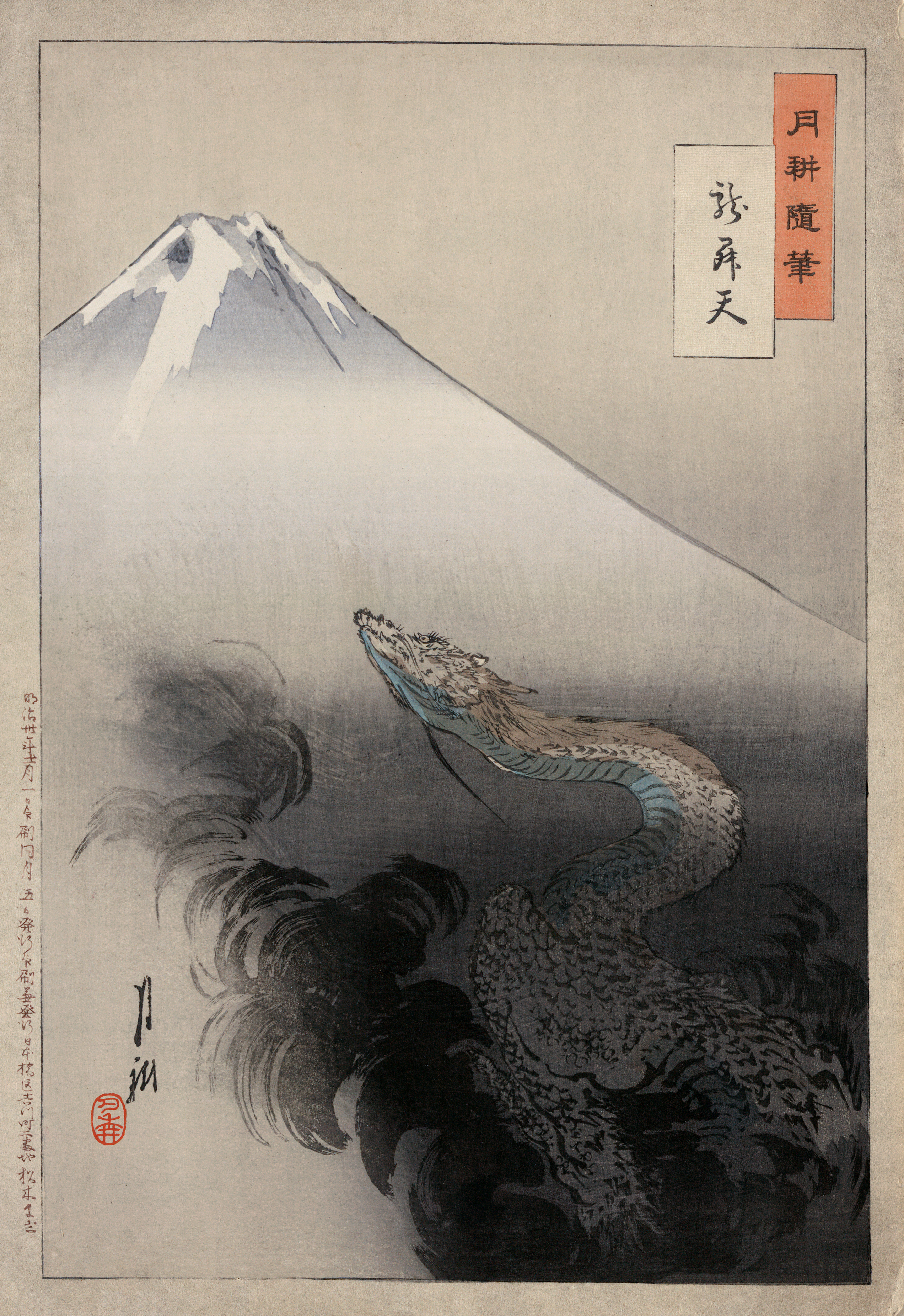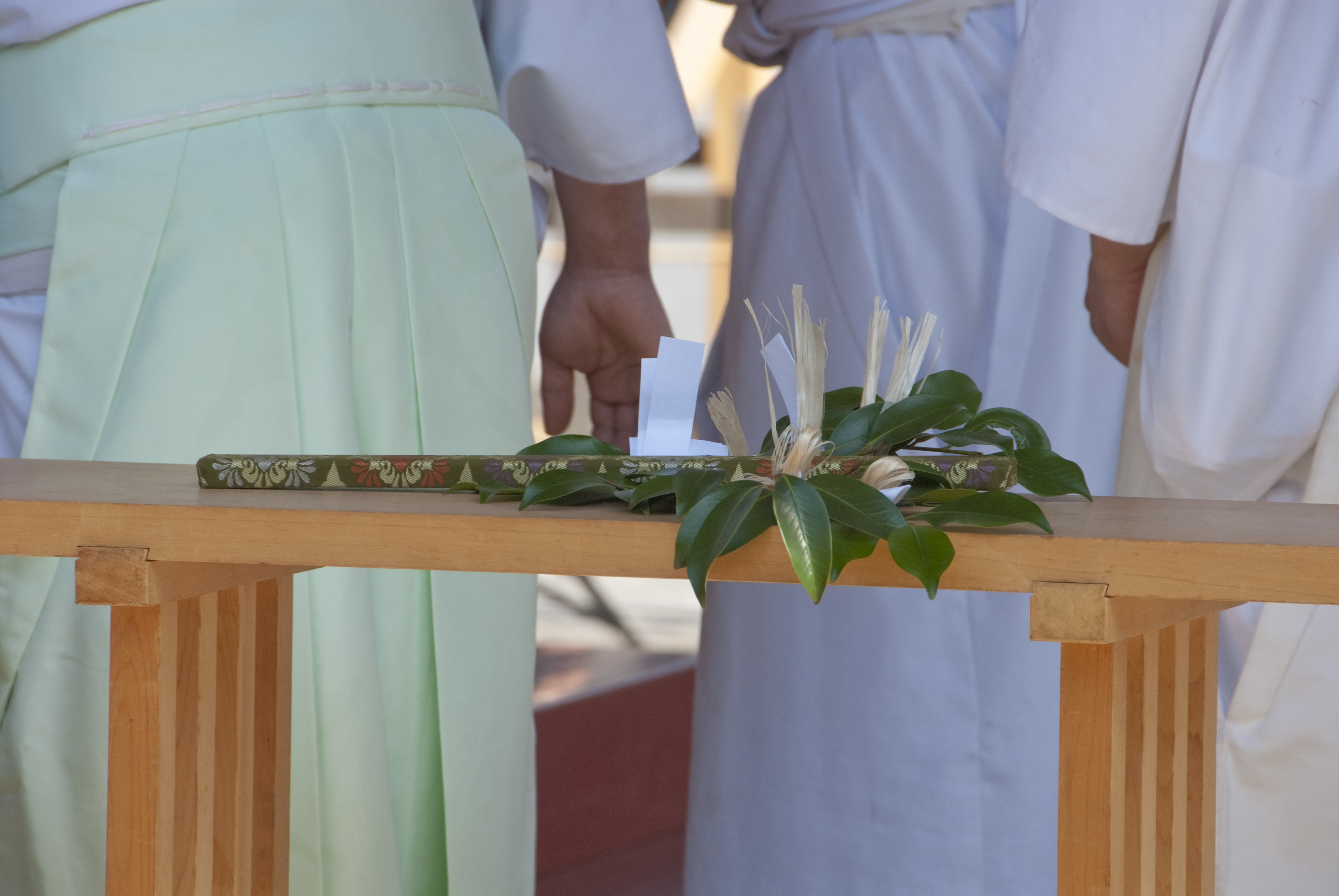|
Wani (dragon)
was a dragon or sea monster in Japanese mythology. Since it is written using the kanji 鰐 (from Chinese ''e'' 鰐 or 鱷 "crocodile; alligator") ''wani'' is translated as "crocodile", or sometimes "shark" (from ''wanizame'' 鰐鮫 "shark"). ''Wani'' first occurs in two ancient Japanese "mytho-histories", the ca. 680 CE ''Kojiki'' and ca. 720 CE '' Nihongi''. They write ''wani'' with the Man'yōgana phonetic transcription 和邇 and the kanji 鰐. The ''Kojiki'' uses ''wani'' 和邇 several times as a proper name (e.g., the Confucianist scholar Wani) and as a sea-monster in two contexts. First, in the " White Hare of Inaba" fable, the gods try and fail to help a ''shiro'' 白 (lit. "white") "naked; hairless" hare that they found crying on a beach. But the Deity Great-Name-Possessor, who came last of all, saw the hare, and said: "Why liest thou weeping?" The hare replied, saying: "I was in the Island of Oki, and wished to cross over to this land, but had no means of crossing ov ... [...More Info...] [...Related Items...] OR: [Wikipedia] [Google] [Baidu] |
Japanese Dragon
Japanese dragons (, ''Nihon no ryū'') are diverse legendary creatures in Japanese mythology and folklore. Japanese dragon myths amalgamate native legends with imported stories about dragons from China, Korea and the Indian subcontinent. The style and appearance of the dragon was heavily influenced by the Chinese dragon, especially the three-clawed ''long'' (龍) dragons which were introduced in Japan from China in ancient times. Like these other East Asian dragons, most Japanese ones are water deities associated with rainfall and bodies of water, and are typically depicted as large, wingless, serpentine creatures with clawed feet. Indigenous Japanese dragons The c. 680 AD ''Kojiki'' and the c. 720 AD '' Nihongi'' mytho-histories have the first Japanese textual references to dragons. "In the oldest annals the dragons are mentioned in various ways," explains de Visser, "but mostly as water-gods, serpent- or dragon-shaped." The ''Kojiki'' and ''Nihongi'' mention several a ... [...More Info...] [...Related Items...] OR: [Wikipedia] [Google] [Baidu] |
Shapeshifting
In mythology, folklore and speculative fiction, shape-shifting is the ability to physically transform oneself through an inherently superhuman ability, divine intervention, demonic manipulation, Magic (paranormal), sorcery, Incantation, spells or having inherited the ability. The idea of shape-shifting is in the oldest forms of totemism and shamanism, as well as the oldest existent literature and Epic poetry, epic poems such as the ''Epic of Gilgamesh'' and the ''Iliad''. The concept remains a common literary device in modern fantasy, children's literature and popular culture. Folklore and mythology Popular shape-shifting creatures in folklore are werewolf, werewolves and vampires (mostly of European, Canadians, Canadian, and Native Americans in the United States, Native American/early American origin), Ichchadhari naag and naagin (shape-shifting cobra), ichchadhari naag and ichchadhari naagin (shape-shifting cobras) of India, the huli jing of East Asia (including the ... [...More Info...] [...Related Items...] OR: [Wikipedia] [Google] [Baidu] |
William George Aston
William George Aston (9 April 1841 – 22 November 1911) was an Anglo-Irish diplomat, author and scholar-expert in the language and history of Japan and Korea. Early life Aston was born near Derry, Ireland.Ricorso Aston, bio notes/ref> He distinguished himself at Queen's College, Belfast (now Queen's University Belfast), which he attended 1859–1863. There he received a very thorough philological training in Latin, Greek, French, German and modern history. One of his professors was James McCosh.Kornicki, Peter "Aston Cambridge and Korea,"Cambridge University, Department of East Asian Studies, 2008. Career Aston was appointed in 1864 student interpreter to the British Legation in Japan. He mastered the theory of the Japanese verb, and in Edo began, with Ernest Mason Satow, those profound researches into the Japanese language which laid the foundations of the critical study of the Japanese language by western scholars. Aston passed the examination for entry to the Consular S ... [...More Info...] [...Related Items...] OR: [Wikipedia] [Google] [Baidu] |
Tamagushi
is a form of Shinto offering made from a ''sakaki''-tree branch decorated with shide strips of washi paper, silk, or cotton. At Japanese weddings, funerals, miyamairi and other ceremonies at Shinto shrines, ''tamagushi'' are ritually presented to the ''kami'' (spirits or gods) by parishioners, shrine maidens or kannushi priests. Linguistic history The Japanese word ''tamagushi'' is usually written with the ''kanji'' ''tama'' 玉 "jade; gem; jewel; precious; ball; bead" and ''kushi'' 串 "string together; skewer; spit; stick", or sometimes written 玉ぐし with ''hiragana'' since the official Tōyō kanji do not include 串. The earliest recorded transcription of ''tamagushi'' is 玉籤, using ''kuji'' 籤 "bamboo slip; (divination) lot; written oracle; raffle; lottery" instead of ''kushi''. The (c. 720 CE) '' Nihon Shoki'' "Chronicles of Japan", which repeatedly mentions a 500-branched ''masakaki'' 真榊 "true ''sakaki''" tree (tr. Aston 1896:43, 47, 121), is the ''locus ... [...More Info...] [...Related Items...] OR: [Wikipedia] [Google] [Baidu] |
Cintamani
Cintāmaṇi (Sanskrit; Devanagari: चिंतामणि; Chinese language, Chinese: 如意寶珠; Pinyin: ''Rúyì bǎozhū''; Japanese Romanization of Japanese, Romaji: ''Nyoihōju; Tamil language, Tamil:சிந்தாமணி''), also spelled as Chintamani (or the ''Chintamani Stone''), is a wishWish fulfillment, -fulfilling Gemstone, jewel within both Hindu and Buddhist traditions, said by some to be the equivalent of the philosopher's stone in Western alchemy. It is one of several Mani Jewel images found in Buddhist scripture. Within Hinduism, it is connected with the gods Vishnu and Ganesha. In Hindu tradition, it is often depicted as a fabulous jewel in the possession of Vishnu as the Kaustubha Mani or as on the forehead of the Nāga, Naga king called as Naga Mani, or on the forehead of the Makara (Hindu mythology), Makara. The ''Yoga Vasistha'', originally written in the 10th century CE, contains a story about the cintamani. The Hindu Vishnu Purana speaks of the " ... [...More Info...] [...Related Items...] OR: [Wikipedia] [Google] [Baidu] |
Tide Jewels
In Japanese mythology, the two tide jewels, named and , were magical gems that the Sea God used to control the tides. The earliest pseudo-historical texts record an ancient myth that the presented the tide jewels to his son-in-law Hoori ''aka'' Yamasachihiko (Prince Luck-of-the-Mountain). Later Japanese writings refers to the tide jewels as being in the possession of the or Dragon King or being housed in his , where the myth of the loan of these jewels became attached to the pseudo-historical conquest of Korea by Empress Jingū. Terminology The Japanese compounds ''kanju'' 干珠 lit. "ebb jewel" and ''manju'' 満珠 lit. "flow jewel" combine ''kan'' 干 (cf. 乾) "dry up; drain off; ebb (tides); recede; oppose" and ''man'' 満 "fill; full; rise (tides); fulfill; satisfy" with ''ju'', ''shu'', or ''tama'' 珠 "gem; jewel; precious stone; pearl; bead". Compare the reversible compounds ''kanman'' 干満 and ''mankan'' 満干 or ''michihi'' 満ち干 meaning "ebb and flow; ... [...More Info...] [...Related Items...] OR: [Wikipedia] [Google] [Baidu] |
Empress Jingū
was a legendary Japanese empress who ruled as a regent following her husband's death in 200 AD. Both the ''Kojiki'' and the ''Nihon Shoki'' (collectively known as the ''Kiki'') record events that took place during Jingū's alleged lifetime. Legends say that after seeking revenge on the people who murdered her husband, she then turned her attention to a "promised land". Jingū is thus considered to be a controversial monarch by historians in terms of her alleged invasion of the Korean Peninsula. This was in turn possibly used as justification for imperial expansion during the Meiji period. The records state that Jingū gave birth to a baby boy whom she named ''Homutawake'' three years after he was conceived by her late husband. Jingū's reign is conventionally considered to have been from 201 to 269 AD, and was considered to be the 15th Japanese imperial ruler until the Meiji period. Modern historians have come to the conclusion that the name "Jingū" was used by later generat ... [...More Info...] [...Related Items...] OR: [Wikipedia] [Google] [Baidu] |
Emperor Chūai
, also known as was the 14th legendary Emperor of Japan, according to the traditional order of succession. Both the ''Kojiki'', and the ''Nihon Shoki'' (collectively known as the ''Kiki'') record events that took place during Chūai's alleged lifetime. Chūai is the first monarch to ascend the throne who was not a son of the previous Emperor as the latter's only child died young. He is also noted for having his capital in Kyushu, rather than Yamato like his predecessors. The records state that Chūai had a wife named ''Okinagatarashihime-no-Mikoto'' (later Jingū), and 2 consorts that all bore him 4 children. Chūai's reign is conventionally considered to have been from 192 to 200 AD. The events leading up to the Emperor's death have been subject to interpretation as they involve a vengeful Kami (spirit) indirectly killing Chūai. This event allegedly occurred after the Emperor disrespectfully scoffed at the Kami's request. His wife Jingū carried out the Kami's request which was ... [...More Info...] [...Related Items...] OR: [Wikipedia] [Google] [Baidu] |
Ebisu (mythology)
, also transliterated or called or , is the Japanese god of fishermen and luck. He is one of the , and the only one of the seven to originate purely from Japan without any Buddhist or Taoist influence. Origins as Hiruko In medieval times, Ebisu's origin came to be tied together with that of ''Hiruko'' - the first child of Izanagi and Izanami, born without bones (or, in some stories, without arms and legs) due to his mother's transgression during the marriage ritual. Hiruko struggled to survive but, as he could not stand, he was cast into the sea in a boat of reeds before his third birthday. The story tells that Hiruko eventually washed ashore—possibly in —and was cared for by the Ainu . It is however believed that Ebisu first arose as a god among fishermen and that his origin as Hiruko was a much later conception, after the worship of him had spread to merchants and farmers. It is also theorized that he was originally a god known as "Kotoshironushi no Mikoto", son of Ōkun ... [...More Info...] [...Related Items...] OR: [Wikipedia] [Google] [Baidu] |




